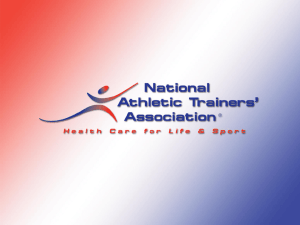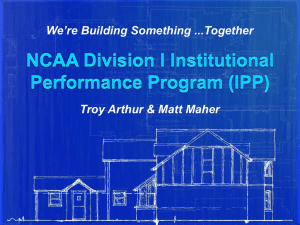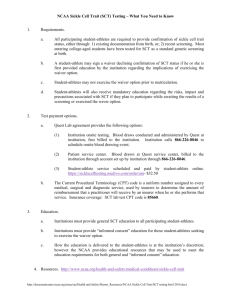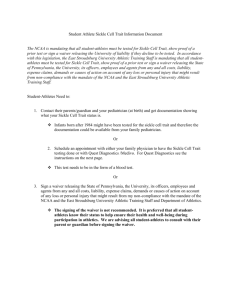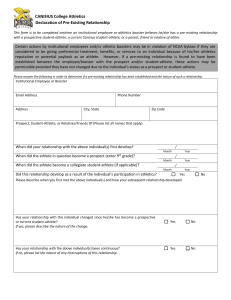doc - CIS
advertisement
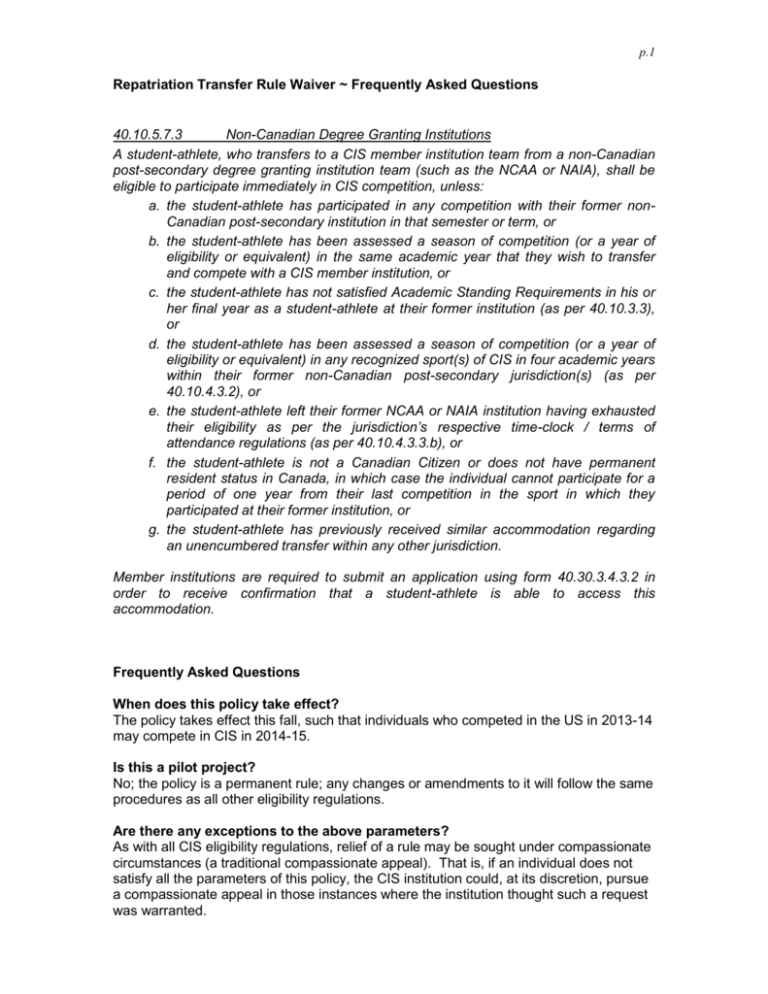
p.1 Repatriation Transfer Rule Waiver ~ Frequently Asked Questions 40.10.5.7.3 Non-Canadian Degree Granting Institutions A student-athlete, who transfers to a CIS member institution team from a non-Canadian post-secondary degree granting institution team (such as the NCAA or NAIA), shall be eligible to participate immediately in CIS competition, unless: a. the student-athlete has participated in any competition with their former nonCanadian post-secondary institution in that semester or term, or b. the student-athlete has been assessed a season of competition (or a year of eligibility or equivalent) in the same academic year that they wish to transfer and compete with a CIS member institution, or c. the student-athlete has not satisfied Academic Standing Requirements in his or her final year as a student-athlete at their former institution (as per 40.10.3.3), or d. the student-athlete has been assessed a season of competition (or a year of eligibility or equivalent) in any recognized sport(s) of CIS in four academic years within their former non-Canadian post-secondary jurisdiction(s) (as per 40.10.4.3.2), or e. the student-athlete left their former NCAA or NAIA institution having exhausted their eligibility as per the jurisdiction’s respective time-clock / terms of attendance regulations (as per 40.10.4.3.3.b), or f. the student-athlete is not a Canadian Citizen or does not have permanent resident status in Canada, in which case the individual cannot participate for a period of one year from their last competition in the sport in which they participated at their former institution, or g. the student-athlete has previously received similar accommodation regarding an unencumbered transfer within any other jurisdiction. Member institutions are required to submit an application using form 40.30.3.4.3.2 in order to receive confirmation that a student-athlete is able to access this accommodation. Frequently Asked Questions When does this policy take effect? The policy takes effect this fall, such that individuals who competed in the US in 2013-14 may compete in CIS in 2014-15. Is this a pilot project? No; the policy is a permanent rule; any changes or amendments to it will follow the same procedures as all other eligibility regulations. Are there any exceptions to the above parameters? As with all CIS eligibility regulations, relief of a rule may be sought under compassionate circumstances (a traditional compassionate appeal). That is, if an individual does not satisfy all the parameters of this policy, the CIS institution could, at its discretion, pursue a compassionate appeal in those instances where the institution thought such a request was warranted. p.2 Why is there an application process for this policy? The application process serves as a means of evaluating the effectiveness of the policy, to collect data on such transfers (similar to what is done in the sports of track & field, cross-country and swimming), and to ensure the policy is adhered to. Can a student-athlete play in a preseason game for an NCAA or NAIA school in August, prior to the start of their fall term classes, and then attend and participate for a CIS school in September because they had a change of heart on attending their NCAA or NAIA school? No. Subject to all other rules the student-athlete could be eligible to participate for the winter term, but not the fall term (and provided they were not already assessed a year of eligibility for their preseason participation). Can a football student-athlete participate in a training camp for an NCAA or NAIA school and attend a CIS school in the same fall term because they had a change of heart on attending an NCAA or NAIA school? Yes. The policy does not impose its “in-semester” restriction on those student-athletes who have not participated on behalf of their NCAA or NAIA institution. Involvement in practicing and training do not disqualify someone from accessing this accommodation. How many credit hours does a transfer student-athlete from the NCAA or NAIA require to access this accommodation? There is no change to the academic requirements of the transfer rule or this accommodation. The individual must have successfully completed a minimum of 18 credit hours within the academic year in order to retain their academic eligibility the following year at their new CIS institution. Please note, the NCAA or NAIA credits are not required to be recognized as transfer credits at their new CIS institution; the credits earned are effectively “banked” by the individual, similar to current practice and policy. Can a US or other citizen access this accommodation? No. The intent of the policy is to repatriate Canadians who have gone to the US for school; it is not an open door for non-Canadians who would be required to sit-out under the traditional transfer rule. Can a Canadian citizen who attended a US high school or prep school prior to attending their NCAA (or NAIA) school access this accommodation? Yes. Can a Canadian citizen participating within the NCAA or NAIA at a Canadianbased school (such as SFU or UBC) access this accommodation? Yes. Although the institution is not located in the US, the intent of the policy is to repatriate student-athletes to the CIS; thus, those student-athletes attending a Canadian-based NCAA institution, or one that also competes in the NAIA, can access this accommodation. Can a student-athlete who received a transfer waiver in the NCAA, such as when they transferred from one NCAA Division 1 school to another NCAA Division 1 school, access this accommodation should they subsequently wish to transfer to a CIS institution? No; however a compassionate appeal would be suggested. Although intended as a repatriation policy, the policy also wishes to respect the academic values of being a student-athlete, which could be questioned in those instances where an individual has sought multiple transfer rule waivers. p.3 Can a student-athlete who did not require a transfer waiver in the NCAA, such as when they transferred to a lower NCAA division, access this accommodation should they subsequently wish to transfer to a CIS institution? Yes. The intent of the policy is to limit access to such an accommodation once in the student-athletes post-secondary career. Can a CIS student-athlete access this accommodation to transfer from one CIS institution to another institution? No. The intent of the policy is to repatriate Canadians who have gone to the US for school; it is not an open door for CIS student-athletes who would be required to sit-out under the traditional transfer rule (with current exceptions provided in the sports of crosscountry, track & field, and swimming).
